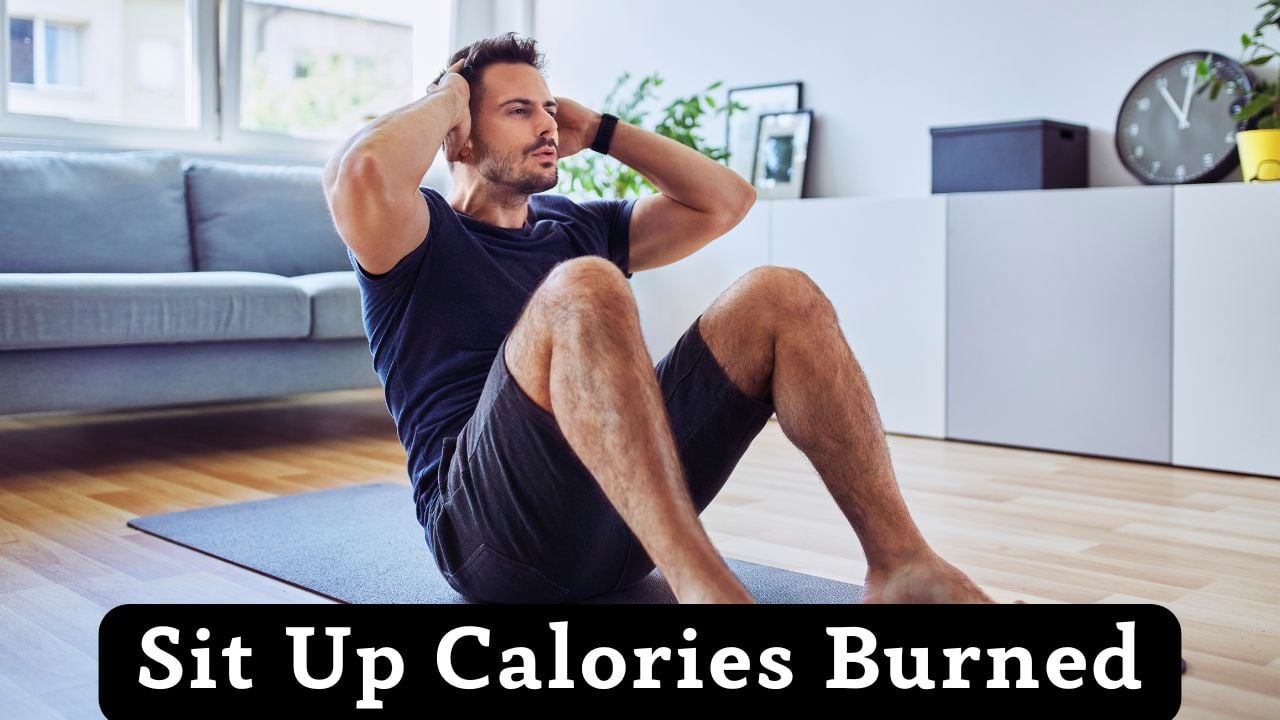Sit-Up Calories Burned Calculator

How Many Calories Do Sit-Ups Burn?
Sit-ups burn 174-551 calories per hour, depending on intensity and body weight. Light-effort sit-ups burn approximately 174-206 cal/hour, moderate-effort sit-ups burn 235-279 cal/hour, while vigorous-effort sit-ups burn 465-551 cal/hour for a person weighing 59-70kg.
Sit-ups primarily engage your rectus abdominis (six-pack muscles), obliques, and hip flexors through repeated spinal flexion. While sit-ups are effective for core strength, they burn fewer calories than full-body calisthenics because they isolate smaller muscle groups.
Research published in Sustainability
demonstrates that calisthenics exercises provide significant cardiovascular and metabolic benefits.
Our calculator uses validated MET values from the Compendium of Physical Activities for accurate estimates. Compare with our plank calculator for other core exercises.
How Sit-Ups Burns Calories
Sit-ups burn calories through muscle contraction, increased heart rate, and elevated oxygen consumption. Each repetition requires your abdominal muscles to overcome body weight resistance, creating metabolic demand. The faster your pace and longer your workout, the more calories you burn.
Clinical studies show
that abdominal exercises significantly improve core strength and muscular endurance.
Unlike cardio exercises that maintain elevated heart rate throughout, sit-ups create intermittent metabolic spikes. Vigorous sit-ups (25-30+ reps/min) elevate heart rate to 60-70% of maximum, creating moderate cardiovascular demand. The rest periods between sets allow partial recovery, making sit-ups primarily a strength exercise rather than cardio.
Our calculator uses MET values ranging from 2.8 (light effort) to 7.5 (vigorous effort). These values come from the Compendium of Physical Activities. Learn more about core strengthening exercises for comprehensive abdominal training.
Sit-Up Calorie Formula & Methodology
📐 Scientific Calorie Calculation
Calories = (Time × MET × 3.5 × Weight) ÷ 200
Understanding Each Component:
- Time: Duration of sit-up workout in minutes
- MET: Metabolic Equivalent specific to intensity (2.8-7.5)
- 3.5: Oxygen consumption constant (ml/kg/min)
- Weight: Your body weight in kilograms
- 200: Conversion factor for kilocalories
📊 Practical Example:
Scenario: 70 kg person, 15 minutes, moderate effort sit-ups (3.8 METs)
Calculation: (15 × 3.8 × 3.5 × 70) ÷ 200 = 69.8 ≈ 70 calories
Result: This person burns approximately 70 calories in 15 minutes of moderate-intensity sit-ups, or about 280 calories per hour.
Sit-Up Intensity MET Values & Performance
| Intensity Level | MET Value | Pace (reps/min) | Calories/Hour (70kg) | Best For |
|---|---|---|---|---|
| Light Effort | 2.8 | 15-20 reps/min | 206 cal/hr | Beginners, form focus |
| Moderate Effort | 3.8 | 20-25 reps/min | 279 cal/hr | Endurance training |
| Vigorous Effort | 7.5 | 25-30+ reps/min | 551 cal/hr | High-intensity training |
Note: MET values based on the Compendium of Physical Activities. Calories calculated for 70 kg (154 lb) person. Actual burn varies with form, range of motion, rest periods, and additional resistance.
Sit-Up Calories by Duration
⏱️ Time-Based Calorie Estimates
Duration significantly impacts total calorie burn. These estimates use moderate-effort sit-ups (3.8 METs) for reliable fitness planning. Balance core training with our BMR calculator and TDEE calculator for complete energy management.
| Time | 130 lb (59 kg) | 150 lb (68 kg) | 175 lb (79 kg) | 200 lb (91 kg) | 225 lb (102 kg) | 250 lb (113 kg) |
|---|---|---|---|---|---|---|
| 5 mins | 20 cal | 22 cal | 26 cal | 30 cal | 34 cal | 37 cal |
| 10 mins | 39 cal | 45 cal | 52 cal | 60 cal | 67 cal | 75 cal |
| 15 mins | 59 cal | 68 cal | 79 cal | 90 cal | 101 cal | 112 cal |
| 20 mins | 78 cal | 90 cal | 105 cal | 120 cal | 135 cal | 150 cal |
| 30 mins | 117 cal | 135 cal | 157 cal | 180 cal | 203 cal | 225 cal |
| 60 mins | 235 cal | 271 cal | 315 cal | 360 cal | 405 cal | 449 cal |
Note: Values based on moderate-effort sit-ups (3.8 METs). Light effort burns 26% less, while vigorous effort burns 97% more. Form quality, rest periods, and variations affect actual calorie burn.
Maximize Your Sit-Up Effectiveness
💪 Techniques to Increase Benefits
Focus on Form Quality: Keep lower back pressed to the floor, engage core before lifting, and avoid pulling on your neck. Proper form increases muscle activation by 30-40% while protecting your spine. Learn proper sit-up technique for optimal results.
Increase Time Under Tension: Slow down your repetitions to 3-4 seconds per rep. This controlled tempo increases metabolic demand and muscle engagement. Build core strength with progressive overload—add reps, sets, or resistance weekly.
Combine with Other Core Exercises: Alternate sit-ups with planks, leg raises, and bicycle crunches for comprehensive core development. Circuit training burns 25-40% more calories than isolated exercises. Use our circuit training calculator for combined workouts. Support recovery with our protein calculator.
FAQs
❓ How accurate is this sit-up calculator?
Our calculator uses the scientifically validated formula: Calories = (Time × MET × 3.5 × Weight) ÷ 200, with MET values from the Compendium of Physical Activities. This provides accuracy within 10-15%, comparable to laboratory measurements for calisthenics exercises.
💪 How many calories does 100 sit-ups burn?
100 sit-ups burn approximately 20-34 calories for a 70 kg person, depending on pace. At moderate pace (22.5 reps/min), 100 sit-ups take about 4.4 minutes and burn roughly 21 calories. At vigorous pace (27.5 reps/min), 100 sit-ups take 3.6 minutes and burn approximately 33 calories.
🏋️ Are sit-ups effective for weight loss?
Sit-ups alone burn relatively few calories (174-551 cal/hour) compared to cardio exercises. However, they build core muscle, which increases resting metabolic rate. For weight loss, combine sit-ups with cardio and proper nutrition. Use our weight loss calculator for personalized goals.
⚡ What burns more calories: sit-ups or crunches?
Sit-ups burn slightly more calories than crunches because they involve greater range of motion and hip flexor engagement. However, crunches isolate abdominals better and reduce lower back strain. Both exercises use similar MET values (2.8-3.8) and burn comparable calories at the same intensity.
💪 Core Exercise & Safety Disclaimer
This tool is for educational and informational purposes only. Sit-ups can strain the lower back if performed incorrectly—maintain proper form, keep lower back pressed to the floor, and avoid pulling on your neck. Consult healthcare professionals, certified personal trainers, or physical therapists before beginning intensive core training programs, especially if you have pre-existing back conditions.
Related
- Push Up Calories Burned Calculator
- Home Activities Calories Burned Calculator
- Calories Burned Mowing The Lawn
- Gardening Calories Burned Calculator
- Calories To Grams Calculator
- Exercise Calories Burned Calculator
- Steps to Calories Calculator
- Total Daily Energy Expenditure (TDEE Calculator)
- Running Calorie Calculator
- Walking Calorie Burned Calculator
References
- Conger SA, Herrmann SD, Willis EA, Nightingale TE, Sherman JR, Ainsworth BE. 2024 Wheelchair Compendium of Physical Activities: An update of activity codes and energy expenditure values. Journal of Sport and Health Science, 2024;13(1): 18-23.
- Herrmann SD, Willis EA, Ainsworth BE, Barreira TV, Hastert M, Kracht CL, Schuna Jr. JM, Cai Z, Quan M, Tudor-Locke C, Whitt-Glover MC, Jacobs DR. 2024 Adult Compendium of Physical Activities: A third update of the energy costs of human activities. Journal of Sport and Health Science, 2024;13(1): 6-12.
- Childs JD, Teyhen DS, Benedict TM, Morris JB, Fortenberry AD, McQueen RM, Preston JB, Wright AC, Dugan JL, George SZ. Effects of sit-up training versus core stabilization exercises on sit-up performance. Med Sci Sports Exerc. 2009 Nov;41(11):2072-83. doi: 10.1249/MSS.0b013e3181a84db2. PMID: 19812508.
- Bianco A, Lupo C, Alesi M, Spina S, Raccuglia M, Thomas E, Paoli A, Palma A. The sit up test to exhaustion as a test for muscular endurance evaluation. Springerplus. 2015 Jul 2;4:309. doi: 10.1186/s40064-015-1023-6. PMID: 26155448; PMCID: PMC4488239.
- Kukić, Filip, Robin Orr, Milan Marković, J. Jay Dawes, Aleksandar Čvorović, and Nenad Koropanovski. 2022. “Factorial and Construct Validity of Sit-Up Test of Different Durations to Assess Muscular Endurance of Police Students” Sustainability 14, no. 20: 13630. https://doi.org/10.3390/su142013630
- Baharuddin, Mohd Yusof & Shanmugam, Malaarvily & Hoo, Boon. (2017). Biomechanics analysis on muscle activation during jumping jack exercise. Jurnal Sains Sukan & Pendidikan Jasmani. 6. 28-35. 10.37134/jsspj.vol6.2.3.2017
- Thulasi Raman, Deepak Ram & C, Ramesh. (2024). The Impact of Metabolic Equivalents (METS) on Physical Activity and Occupational Mental Health among IT Professionals Using mHealth. American Journal of Educational Research. 12. 12-19. 10.12691/education-12-1-2.
Use our online calculator to determine the calories burned while doing sit-ups. Get precise results based on your weight, repetitions, & Intensity level.

Manish is a NASM-certified fitness and nutrition coach with over 10 years of experience in weight lifting and fat loss fitness coaching. He specializes in gym-based training and has a lot of knowledge about exercise, lifting technique, biomechanics, and more.
Through “Fit Life Regime,” he generously shares the insights he’s gained over a decade in the field. His goal is to equip others with the knowledge to start their own fitness journey.
